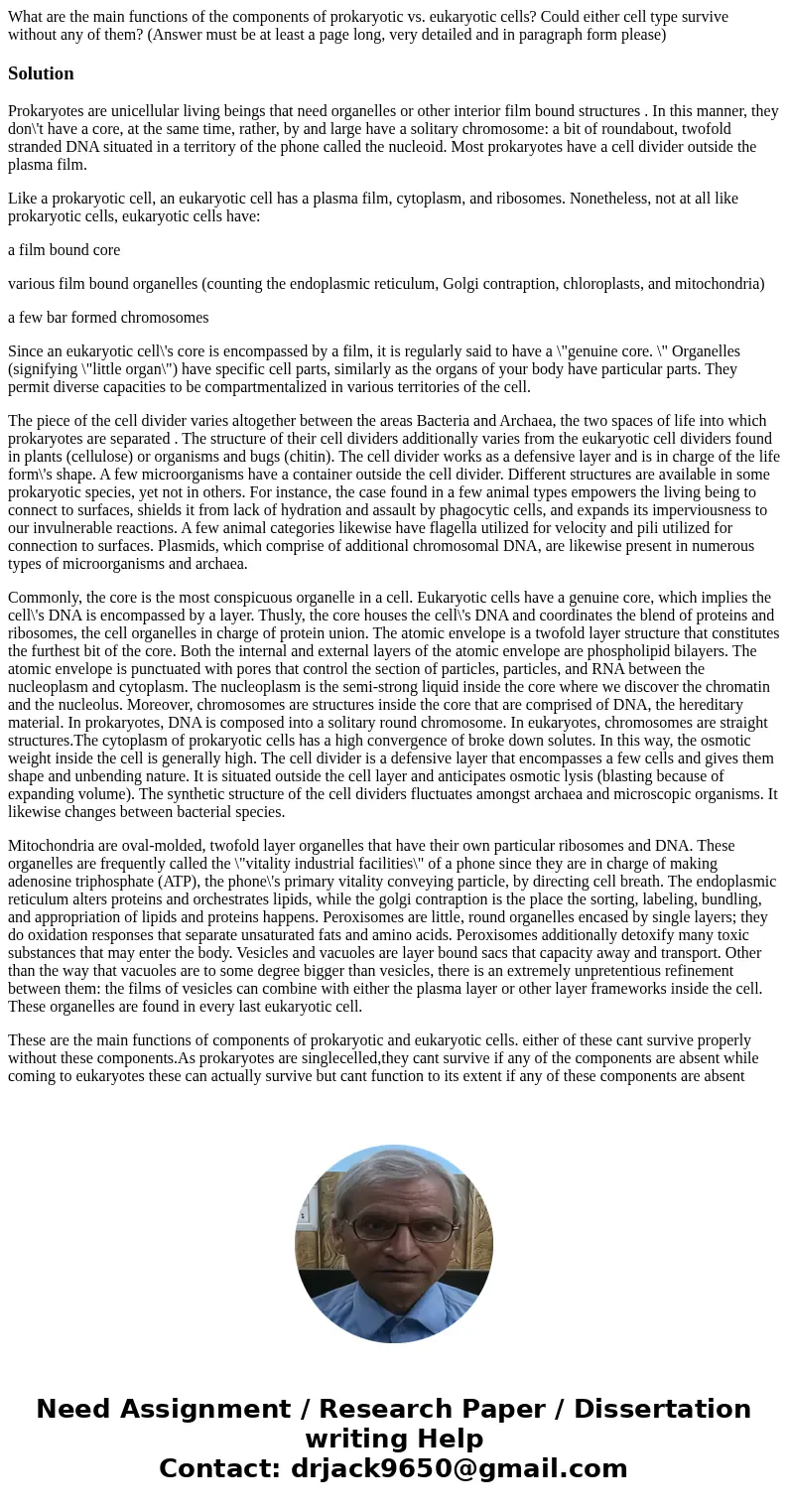What are the main functions of the components of prokaryotic
What are the main functions of the components of prokaryotic vs. eukaryotic cells? Could either cell type survive without any of them? (Answer must be at least a page long, very detailed and in paragraph form please)
Solution
Prokaryotes are unicellular living beings that need organelles or other interior film bound structures . In this manner, they don\'t have a core, at the same time, rather, by and large have a solitary chromosome: a bit of roundabout, twofold stranded DNA situated in a territory of the phone called the nucleoid. Most prokaryotes have a cell divider outside the plasma film.
Like a prokaryotic cell, an eukaryotic cell has a plasma film, cytoplasm, and ribosomes. Nonetheless, not at all like prokaryotic cells, eukaryotic cells have:
a film bound core
various film bound organelles (counting the endoplasmic reticulum, Golgi contraption, chloroplasts, and mitochondria)
a few bar formed chromosomes
Since an eukaryotic cell\'s core is encompassed by a film, it is regularly said to have a \"genuine core. \" Organelles (signifying \"little organ\") have specific cell parts, similarly as the organs of your body have particular parts. They permit diverse capacities to be compartmentalized in various territories of the cell.
The piece of the cell divider varies altogether between the areas Bacteria and Archaea, the two spaces of life into which prokaryotes are separated . The structure of their cell dividers additionally varies from the eukaryotic cell dividers found in plants (cellulose) or organisms and bugs (chitin). The cell divider works as a defensive layer and is in charge of the life form\'s shape. A few microorganisms have a container outside the cell divider. Different structures are available in some prokaryotic species, yet not in others. For instance, the case found in a few animal types empowers the living being to connect to surfaces, shields it from lack of hydration and assault by phagocytic cells, and expands its imperviousness to our invulnerable reactions. A few animal categories likewise have flagella utilized for velocity and pili utilized for connection to surfaces. Plasmids, which comprise of additional chromosomal DNA, are likewise present in numerous types of microorganisms and archaea.
Commonly, the core is the most conspicuous organelle in a cell. Eukaryotic cells have a genuine core, which implies the cell\'s DNA is encompassed by a layer. Thusly, the core houses the cell\'s DNA and coordinates the blend of proteins and ribosomes, the cell organelles in charge of protein union. The atomic envelope is a twofold layer structure that constitutes the furthest bit of the core. Both the internal and external layers of the atomic envelope are phospholipid bilayers. The atomic envelope is punctuated with pores that control the section of particles, particles, and RNA between the nucleoplasm and cytoplasm. The nucleoplasm is the semi-strong liquid inside the core where we discover the chromatin and the nucleolus. Moreover, chromosomes are structures inside the core that are comprised of DNA, the hereditary material. In prokaryotes, DNA is composed into a solitary round chromosome. In eukaryotes, chromosomes are straight structures.The cytoplasm of prokaryotic cells has a high convergence of broke down solutes. In this way, the osmotic weight inside the cell is generally high. The cell divider is a defensive layer that encompasses a few cells and gives them shape and unbending nature. It is situated outside the cell layer and anticipates osmotic lysis (blasting because of expanding volume). The synthetic structure of the cell dividers fluctuates amongst archaea and microscopic organisms. It likewise changes between bacterial species.
Mitochondria are oval-molded, twofold layer organelles that have their own particular ribosomes and DNA. These organelles are frequently called the \"vitality industrial facilities\" of a phone since they are in charge of making adenosine triphosphate (ATP), the phone\'s primary vitality conveying particle, by directing cell breath. The endoplasmic reticulum alters proteins and orchestrates lipids, while the golgi contraption is the place the sorting, labeling, bundling, and appropriation of lipids and proteins happens. Peroxisomes are little, round organelles encased by single layers; they do oxidation responses that separate unsaturated fats and amino acids. Peroxisomes additionally detoxify many toxic substances that may enter the body. Vesicles and vacuoles are layer bound sacs that capacity away and transport. Other than the way that vacuoles are to some degree bigger than vesicles, there is an extremely unpretentious refinement between them: the films of vesicles can combine with either the plasma layer or other layer frameworks inside the cell. These organelles are found in every last eukaryotic cell.
These are the main functions of components of prokaryotic and eukaryotic cells. either of these cant survive properly without these components.As prokaryotes are singlecelled,they cant survive if any of the components are absent while coming to eukaryotes these can actually survive but cant function to its extent if any of these components are absent

 Homework Sourse
Homework Sourse